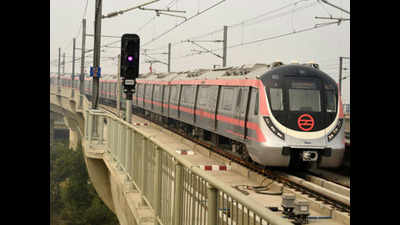- News
- City News
- delhi News
- In four months, a tenth of world’s driverless Metro network in Delhi
Trending
This story is from February 25, 2021
In four months, a tenth of world’s driverless Metro network in Delhi
Delhi Metro took a huge technological leap on December 28 last year when Prime Minister Narendra Modi flagged off the country’s first-ever fully automated driverless train service on Magenta Line. In less than four months, Delhi Metro Rail Corporation (DMRC) will start the same operations on Pink Line (Majlis Park-Shiv Vihar), making the “driverless network” 9% of the world’s total driverless Metro network.

DMRC officials said that by June, driverless train operations would begin on the 57km Pink Line, taking DMRC’s entire driverless network to 94km.
NEW DELHI: Delhi Metro took a huge technological leap on December 28 last year when Prime Minister Narendra Modi flagged off the country’s first-ever fully automated driverless train service on Magenta Line. In less than four months, Delhi Metro Rail Corporation (DMRC) will start the same operations on Pink Line (Majlis Park-Shiv Vihar), making the “driverless network” 9% of the world’s total driverless Metro network.
DMRC officials said that by June, driverless train operations would begin on the 57km Pink Line, taking DMRC’s entire driverless network to 94km. This network will cross the 100km mark when the 12.5km Maujpur-Majlis Park extension of the corridor, which is being constructed as part of Delhi Metro’s Phase-IV project, gets completed next year.
The reason driverless train operations are possible on both Magenta (Janakpuri West-Botanical Garden) and Pink Lines is the state-of-the-art communication-based train control (CBTC) signalling technology. Compared with the technology used in older corridors, CBTC allows more efficient and safe train operations. DMRC has been carrying out trial runs in driverless mode in non-revenue hours and has also got its signalling system reviewed by experts for eventual implementation of unattended train operations (UTO).
Driverless operations have been made possible due to changes in the existing general rules for running trains that takes into account the presence of a driver and the guidelines of handling any emergency involving the presence of a driver. The new Metro Railway General Rules 2020 takes into account driverless operations.
Unlike Magenta Line, Pink Line operates as two different sections due to a “missing link” at Trilokpuri where DMRC has been unable to construct a viaduct. However, it is expected to be bridged and uninterrupted train movement on the entire corridor is slated to begin by June.
In driverless operations, DMRC has replaced drivers with “roaming attendants”, who are multi-skilled personnel, apart from being trained as drivers. The Pink and Magenta lines are planned to be operated in UTO mode, when even an attendant wouldn’t be present, in a phased manner.
Magenta Line switched from automatic train operation mode to driverless train operation mode last December and Pink Line will do so in the next four months. However, trains, signalling system, traction, track and depot design of Magenta and Pink lines are compliant for operation in UTO mode and eventually, DMRC plans to move to this mode on both corridors.
DMRC officials said that by June, driverless train operations would begin on the 57km Pink Line, taking DMRC’s entire driverless network to 94km. This network will cross the 100km mark when the 12.5km Maujpur-Majlis Park extension of the corridor, which is being constructed as part of Delhi Metro’s Phase-IV project, gets completed next year.
The reason driverless train operations are possible on both Magenta (Janakpuri West-Botanical Garden) and Pink Lines is the state-of-the-art communication-based train control (CBTC) signalling technology. Compared with the technology used in older corridors, CBTC allows more efficient and safe train operations. DMRC has been carrying out trial runs in driverless mode in non-revenue hours and has also got its signalling system reviewed by experts for eventual implementation of unattended train operations (UTO).
Driverless operations have been made possible due to changes in the existing general rules for running trains that takes into account the presence of a driver and the guidelines of handling any emergency involving the presence of a driver. The new Metro Railway General Rules 2020 takes into account driverless operations.
“The rules had to be changed for starting driverless operations on Magenta Line but now since the new rules are in place, driverless operations on Pink Line can begin easily. However, trials and tests are going on and other necessary clearances are required before we start these operations,” an official said.
Unlike Magenta Line, Pink Line operates as two different sections due to a “missing link” at Trilokpuri where DMRC has been unable to construct a viaduct. However, it is expected to be bridged and uninterrupted train movement on the entire corridor is slated to begin by June.
In driverless operations, DMRC has replaced drivers with “roaming attendants”, who are multi-skilled personnel, apart from being trained as drivers. The Pink and Magenta lines are planned to be operated in UTO mode, when even an attendant wouldn’t be present, in a phased manner.
Magenta Line switched from automatic train operation mode to driverless train operation mode last December and Pink Line will do so in the next four months. However, trains, signalling system, traction, track and depot design of Magenta and Pink lines are compliant for operation in UTO mode and eventually, DMRC plans to move to this mode on both corridors.
End of Article
FOLLOW US ON SOCIAL MEDIA










